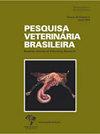动物中钙醋不动杆菌-鲍曼不动杆菌复合体:鉴定和耐药谱
IF 0.8
4区 农林科学
Q3 VETERINARY SCIENCES
引用次数: 0
摘要
摘要:不动杆菌(Acinetobacter spp.)正在成为一种重要的人类和动物病原体,主要是由于对抗菌素的内在和获得性耐药。尽管与公共卫生相关,但人们对不同不动杆菌种类的流行程度、作用以及动物源分离株的抗微生物药物耐药性知之甚少。传统的表型测试可能无法区分不动杆菌种类,因此分子分析通常需要作为补充方法。本研究的目的是评估从动物感染(包括尿路感染、中耳炎、皮炎和足皮炎)中分离出的钙醋不动杆菌-鲍曼不动杆菌(Acb)复合物的发生情况,以及其对不同抗微生物药物(包括碳青霉烯类)的耐药性。采用MALDI-TOF法和多重PCR法对分离的革兰氏阴性球菌进行鉴定,采用圆盘扩散法检测PCR法检测耐多药基因和碳青霉烯类耐药基因。MALDI-TOF技术鉴定出21株Acb复群菌株(10株pittii、8株鲍曼不动杆菌、3株医院不动杆菌、1株护理不动杆菌和1株venetianus)。多重PCR证实了20株菌株的MALDI-TOF结果。8株(34.78%)为耐多药菌株,其中鲍曼不动杆菌占50%(4/8),皮氏不动杆菌占37.5%(3/8),医院不动杆菌占12.5%(1/8)。没有分离株表现出碳青霉烯酶产生的表型。从碳青霉烯酶耐药基因来看,26.09%(6/23)的菌株存在一个或多个碳青霉烯酶基因。其中,50%(3/6)的患者仅出现blaVIM, 33.33%(2/6)的患者仅出现blaIMP, 16.67%(1/6)的患者同时出现blaIMP和blaVIM。这些基因在pittii菌株中检出最多(66.67%,4/6)。本研究为进一步了解动物源性不动杆菌的发生和耐药概况提供了依据。本文章由计算机程序翻译,如有差异,请以英文原文为准。
Acinetobacter calcoaceticus-Acinetobacter baumannii complex in animals: identification and antimicrobial resistance profile
ABSTRACT: Acinetobacter spp. is emerging as an important human and veterinary pathogen, mostly due to intrinsic and acquired resistance to antimicrobials. Despite its public health relevance, little is known about the prevalence, role of different Acinetobacter species and antimicrobial resistance profile of animal-origin isolates. Traditional phenotypic tests may fail to discriminate Acinetobacter species, therefore molecular analyses are often required as a complementary approach. The objectives of this study were to evaluate the occurrence of strains of the Acinetobacter calcoaceticus-Acinetobacter baumannii (Acb) complex isolated from animal infections including urinary tract infections, otitis, piodermitis and pododermatitis, and its resistance profile against different antimicrobial classes, including carbapenems. All Gram-negative coccobacilli isolates were characterized by MALDI-TOF and multiplex PCR, and the disk diffusion test was used to investigate multi-drug resistance (MDR) and carbapenem resistance genes by PCR as preconized by the standard guidelines. MALDI-TOF technique identified 21 strains belonging to the Acb complex (10 A. pittii, 8 A. baumannii, 3 A. nosocomialis, 1 A. ursingii, and 1 A. venetianus). Multiplex PCR confirmed the results of MALDI-TOF for 20 strains. Eight strains (34.78%) were classified as MDR, being 50% (4/8) A. baumannii, 37.5% (3/8) A. pittii, and 12.5% (1/8) A. nosocomialis. None of the isolates presented phenotypic carbapenemase production. Considering the carbapenem resistance genes, 26.09% (6/23) of the isolates presented one or more carbapenemase genes. From these, 50% (3/6) presented only bla VIM, 33.33% (2/6) presented only blaIMP, and 16.67% (1/6) presented blaIMP e blaVIM, simultaneously. These genes were detected among A. pittii isolates mostly (66.67%, 4/6). This study provides further insights into the occurrence and resistance profile of Acinetobacter of animal origin.
求助全文
通过发布文献求助,成功后即可免费获取论文全文。
去求助
来源期刊

Pesquisa Veterinaria Brasileira
农林科学-兽医学
CiteScore
1.30
自引率
16.70%
发文量
41
审稿时长
9-18 weeks
期刊介绍:
Pesquisa Veterinária Brasileira - Brazilian Journal of Veterinary Research (http://www.pvb.com.br), edited by the Brazilian College of Animal Pathology in partnership with the Brazilian Agricultural Research Organization (Embrapa) and in collaboration with other veterinary scientific associations, publishes original papers on animal diseases and related subjects. Critical review articles should be written in support of original investigation. The editors assume that papers submitted are not being considered for publication in other journals and do not contain material which has already been published. Submitted papers are peer reviewed.
The abbreviated title of Pesquisa Veterinária Brasileira is Pesqui. Vet. Bras.
 求助内容:
求助内容: 应助结果提醒方式:
应助结果提醒方式:


